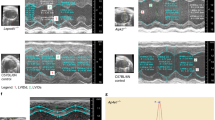Abstract
It is generally considered that the development of secundum atrial septal defect (ASDII) or oval fossa defect is the result of excessive resorption of the embryological atrial septum primum, but this does not seem to explain all defects. We investigated 58 postmortem hearts with an ASDII and 22 normal hearts from patients ranging in age from 1 day to 49 years. The different structures of the oval fossa were examined. In 86% of the specimens, the defects were the result of a malformation of the valvula foraminis ovalis or embryological atrial septum primum, and in 14% an absent superior limbus (septum secundum) was the cause of the interatrial communication. The “septum primum” ASDs were divided into four subgroups based on the degree of deficiency of the septum primum and position of the ostium secundum within the septum primum. We conclude that the morphogenesis of ASDII is variable and both septum primum and septum secundum defects occur, which may be relevant in view of genetic studies that may lead to further differentiation of patients with and without genetically determined ASDIIs.



Similar content being viewed by others
References
RH Anderson NA Brown (1996) ArticleTitleThe anatomy of the heart revisited Anat Rec 246 1–7 Occurrence Handle8876818 Occurrence Handle10.1002/(SICI)1097-0185(199609)246:1<1::AID-AR1>3.0.CO;2-Y Occurrence Handle1:STN:280:ByiD3s%2FovFQ%3D
DW Benson A Sharkey D Fatkin et al. (1998) ArticleTitleReduced penetrance, variable expressivity, and genetic heterogeneity of familial atrial septal defects Circulation 97 2043–2044 Occurrence Handle9610535 Occurrence Handle1:STN:280:DyaK1c3nt1SltA%3D%3D
C Biben R Weber S Kesteven et al. (2000) ArticleTitleCardiac septal and valvular dysmorphogenesis in mice heterozygous for mutations in the homeobox gene Nkx2-5 Circ Res 87 888–889 Occurrence Handle11073884 Occurrence Handle1:CAS:528:DC%2BD3cXoslygs70%3D
NA Blom AC Gittenberger-de Groot TH Jongeneel et al. (2001) ArticleTitleNormal development of the pulmonary veins in human embryos and formulation of a morphogenetic concept for sinus venosus defects Am J Cardiol 87 305–309 Occurrence Handle11165965 Occurrence Handle10.1016/S0002-9149(00)01363-1 Occurrence Handle1:STN:280:DC%2BD3M7is1Ontg%3D%3D
BG Bruneau M Logan N Davis et al. (1999) ArticleTitleChamber-specific cardiac expression of Tbx5 and heart defects in Holt–Oram syndrome Dev Biol 211 100–108 Occurrence Handle10373308 Occurrence Handle10.1006/dbio.1999.9298 Occurrence Handle1:CAS:528:DyaK1MXjvVCit74%3D
M Carminati M Chessa G Butera et al. (2001) ArticleTitleTranscatheter closure of atrial septal defects with the STARFlex device: early results and follow-up J Interv Cardiol 14 319–324 Occurrence Handle12053391 Occurrence Handle1:STN:280:DC%2BD38zht1Sntw%3D%3D
KC Chan MJ Godman (1993) ArticleTitleMorphological variations of fossa ovalis atrial septal defects (secundum): feasibility for transcutaneous closure with the clam-shell device Br Heart J 69 52–55 Occurrence Handle8457395 Occurrence Handle1:STN:280:ByyB3cjovVQ%3D
KC Chan MJ Godman K Walsh et al. (1999) ArticleTitleTranscatheter closure of atrial septal defect and interatrial communications with a new self-expanding nitinol double disc device (Amplatzer septal occluder): multicentre UK experience Heart 82 300–306 Occurrence Handle10455079 Occurrence Handle1:STN:280:DyaK1Mzoslahtw%3D%3D
ZD Du P Koenig QL Cao et al. (2002) ArticleTitleComparison of transcatheter closure of secundum atrial septal defect using the Amplatzer septal occluder associated with deficient versus sufficient rims Am J Cardiol 90 865–869 Occurrence Handle12372575 Occurrence Handle10.1016/S0002-9149(02)02709-1
SM Ferreira SY Ho RH Anderson (1992) ArticleTitleMorphological study of defects of the atrial septum within the oval fossa: implications for transcatheter closure of left-to-right shunt Br Heart J 67 316–320 Occurrence Handle1389707 Occurrence Handle1:STN:280:ByyD3c7otV0%3D
G Fischer J Stieh A Uebing et al. (2003) ArticleTitleExperience with transcatheter closure of secundum atrial septal defects using the Amplatzer septal occluder: a single centre study in 236 consecutive patients Heart 89 199–204 Occurrence Handle12527678 Occurrence Handle10.1136/heart.89.2.199 Occurrence Handle1:STN:280:DC%2BD3s%2FitVOntQ%3D%3D
CJ Hatcher MS Kim CT Basson (2000) ArticleTitleAtrial form and function: lessons from human molecular genetics Trends Cardiovasc Med 10 93–101 Occurrence Handle11428001 Occurrence Handle10.1016/S1050-1738(00)00056-6 Occurrence Handle1:CAS:528:DC%2BD3MXhvFCnsbw%3D
X Jiang DH Rowitch P Soriano AP McMahon HM Sucov (2000) ArticleTitleFate of the mammalian cardiac neural crest Development 127 1607–1616 Occurrence Handle10725237 Occurrence Handle1:CAS:528:DC%2BD3cXjsVWksb8%3D
R Kaulitz T Paul G Hausdorf (1998) ArticleTitleExtending the limits of transcatheter closure of atrial septal defects with the double umbrella device (CardioSEAL) Heart 80 54–59 Occurrence Handle9764060 Occurrence Handle1:STN:280:DyaK1cvjs1Gmsw%3D%3D
YV Maeno LN Benson PR McLaughlin C Boutin (2000) ArticleTitleDynamic morphology of the secundum atrial septal defect evaluated by three dimensional transoesophageal echocardiography Heart 83 673–677 Occurrence Handle10814628 Occurrence Handle10.1136/heart.83.6.673 Occurrence Handle1:STN:280:DC%2BD3c3ns1Wqtw%3D%3D
PS Rao (1998) ArticleTitleTranscatheter closure of atrial septal defect: are we there yet? J Am Coll Cardiol 31 1117–1119 Occurrence Handle9562016 Occurrence Handle10.1016/S0735-1097(98)80382-3 Occurrence Handle1:STN:280:DyaK1c3itVCrsQ%3D%3D
JJ Schott DW Benson CT Basson et al. (1998) ArticleTitleCongenital heart disease caused by mutations in the transcription factor NKX2-5 Science 281 108–111 Occurrence Handle9651244 Occurrence Handle10.1126/science.281.5373.108 Occurrence Handle1:CAS:528:DyaK1cXksVOmtro%3D
S Webb NA Brown RH Anderson (1996) ArticleTitleThe structure of the mouse heart in late fetal stages Anat Embryol (Berlin) 194 37–47 Occurrence Handle1:STN:280:BymA1MzmsVw%3D
A Wessels RH Anderson RR Markwald et al. (2000) ArticleTitleAtrial development in the human heart: an immunohistochemical study with emphasis on the role of mesenchymal tissues Anat Rec 259 288–300 Occurrence Handle10861362 Occurrence Handle10.1002/1097-0185(20000701)259:3<288::AID-AR60>3.0.CO;2-D Occurrence Handle1:STN:280:DC%2BD3cvhs1GlsQ%3D%3D
Author information
Authors and Affiliations
Corresponding author
Rights and permissions
About this article
Cite this article
Blom, N., Ottenkamp, J., Jongeneel, T. et al. Morphogenetic Differences of Secundum Atrial Septal Defects. Pediatr Cardiol 26, 338–343 (2005). https://doi.org/10.1007/s00246-004-0711-8
Published:
Issue Date:
DOI: https://doi.org/10.1007/s00246-004-0711-8




